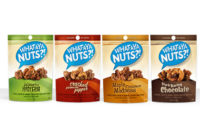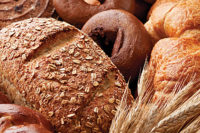Bakers and snack producers know that food safety and sanitation are intertwined, so they work continuously to ensure that their companies meet all local, state and federal food manufacturing guidelines. The Food Safety Management Act (FMSA), passed into law in January 2011, will mean even more government oversight for these food manufacturers and others, but companies that already have stringent sanitation procedures in place will be better prepared to handle the new challenges.
Equipment designed to facilitate sanitation will also help bakers and snack producers comply more easily with FSMA regulations. Mixer manufacturers, for instance, are continuously working with their customers to develop new systems, as well as improve existing models.
“Allergens and cross contamination of doughs are a big concern,” says Terry Bartsch, vice president of sales, Shaffer, Urbana, Ohio, a Bundy Baking Solutions company that offers horizontal mixers and dough-processing equipment. “To prevent cross contamination, sanitation of the mixer is required more often and diligence is more important than ever.”
But more sanitation can mean more downtime for bakers and snack producers. Bartsch notes that mixer manufacturers help bakeries reduce the time it takes to sanitize their mixers by designing equipment that’s easy to clean. “This can be done by eliminating areas that dough and contaminants can dwell in, providing features that help speed the sanitation process and incorporating design options that allow for a more sanitary process,” he explains.
Bartsch cites several mixer design features that can address these issues and others. “A two-way tilt for hand-loading ingredients in the back of the mixer prevents contamination of any product in the front of the mixer in a dough pump, chunker or other processing equipment,” he says. “An open-frame design can remove components from under the mixing bowl, which greatly reduces sanitation time. Other features such as shaft seals that can be disassembled quickly and have retainable mounting hardware can also decrease sanitation time and prevent the loss of components.”
Shaffer recently developed a new design for its open-frame mixers. “It’s basically a hybrid of the open-frame and enclosed frame mixer, offering the best of both designs,” Bartsch says. “The mixer uses a direct drive and keeps the area under the bowl open like the current design. The tilt system, including the hydraulic cylinder and hydraulic unit, is in a water-tight, sealed enclosure. This means that bakeries do not have to perform sanitation on the hydraulic components and, in fact, should not have to open the enclosure unless they are doing maintenance procedures.”
The company also updated its bowl seal design to eliminate up to 99% of flour leaks from the bowl during the mixing cycle. In addition, its rotary face shaft seals now require no lubrication, can be easily inspected and cleaned and use retainable mounting hardware.
“Our sanitary mixers and blenders are built from high-quality stainless steel and are polished to at least 150-grit finish with each weld ‘radiused’ and ground smooth to prevent material buildup and facilitate easier cleanup,” says Christine Banaszek, applications engineer, Charles Ross & Son Co., Hauppauge, N.Y., which manufacturers a variety of food-processing equipment, including mixers and blenders.
Among the company mixers offerings are double planetary mixer and planetary dispersers, designed for high-viscosity food processing. The sanitary mixers consist of two agitators that rotate on their respective axes as they revolve around the mix vessel.
Equipped with the patented High Viscosity (HV) blades, Ross double planetary mixers are suitable for kneading dough and mixing thick pastes with viscosities up to 6 million centipoise. The helical and precisely sloped HV blades pass each other with a slicing motion, moving product forward and downward, which, according to Banaszek, promotes superior top-to-bottom mixing of a nonflowable material, while keeping it within the mixing zone at all times.
The Ross PowerMix planetary disperser is a hybrid design that combines planetary mixing with high-speed dispersion. The planetary blade orbits through the mix can, continuously sweeping the vessel walls, as well as the vessel bottom, and carrying material toward the high-speed disperser. The sawtooth blades of the disperser create a vortex into which solids can be added and quickly incorporated. This system can handle a wide range of viscosities, from waterlike to around 2 million centipoise.
Aside from fluids, dry powder blends also can be prepared in the multifunctional double planetary mixer and PowerMix planetary disperser.
Banaszek adds that inherent design features of Ross food mixers support sanitary production: Close tolerances on the agitators and troughs of its ribbon blenders that eliminate dead zones; the absence of shaft seals, bearings, packing glands and stuffing boxes submerged in the product zone of its double planetary mixers and planetary dispersers; hydraulic lifts on all change-can Ross mixers that allow complete access to agitators for between-batch cleaning; bushingless inline rotor/stator high shear mixers; and more.
“At the same time, we continue to refine and develop optional features to fit a particular customer’s processing needs: Custom charge ports and bag dump stations; flush plug valves; [clean-in-place] spray manifolds; loadcells; built-in vacuum pumps; integrated controls; and so on,” she explains.
Stephen Bloom, vice president of Allied Bakery Equipment, says that “thanks to the new Genesi design, all Sancassiano mixers comply with the latest [U.S. Department of Agriculture] and [Food and Drug Administration] recommendations in terms of food safety and sanitation.” The Santa Fe Springs, Calif., company designs and develops baked goods production lines and is an importer, distributor and manufacturer’s representative for a variety of bakery equipment and system brands, including that of Sancassiano S.p.A. in Italy, which introduced two mixer technologies: The Kryos; and the Revo.
According to Bloom, the Kryos mixer is “the first and only vertical mixer with a static jacketed bowl for dough temperature control. This machine combines the advantages of the horizontal mixer (big batches, dough temperature control, static bowl, etc.) with those of a vertical mixer (better batch consistency, better dough development, including increased product hydration, flexibility in batch dimensions, etc.).”
The Kyros mixer is available with a bottom discharge system that allows for easy integration into production floors already oriented to dough troughs. “Alternatively, together with a series of pinch conveyors, the necessity for operators, extra bowls/troughs and elevator can often be eliminated completely,” Bloom says.
The Revo mixer was developed to improve the mixing of cookies, pies and gluten-free products. According to Bloom, it can provide quicker mixing time, excellent ingredient amalgamation and easier incorporation of manual additions. The independent speed of the tools together with the possibility to reverse their sense of rotation make the mixer flexible for many different recipes.
Both mixers have an oil-free drive system that eliminates the problem of product contamination; no crevices, dead areas or sharp corners and angles inside the mixing bowls; no bolts or screws in the mixing chamber; and horizontal surfaces with a 3-deg. incline (wherever possible) to avoid water buildup. Sancassiano also increased the models’ clearance from the plant floor to facilitate sanitation.
“Our mixers are designed for no-tool cleaning,” says Jim Warren, director, continuous mixing sales at Reading Bakery Systems. “Not only are they easy to clean, [they’re] also easy to inspect after cleaning. [Clean-in-place] designs are available and all materials are FDA-approved.” A part of the Markel Bakery Group, the Robesonia, Pa.-based company manufactures bakery equipment, including continuous and spindle mixers, as well as provides turnkey processing systems and support services for the snack food industry.
“Continuous mixing technology continues to move forward at RBS,” Warren says. “With our new sister company, AMF [Bakery Systems in Richmond, Va.], we now offer a continuous mixer specifically designed for the bun and bread industries. This was accomplished by blending existing mixer designs to create a mixer that quickly reaches the ‘cleanup’ stage, followed by a gentle development section.”
According to Ed Fay, president of CMC America Corp., a Joliet, Ill.-based company that makes industrial dough mixers, all CMC America equipment is available in FDA and American Meat Institute (AMI) designs. “The AMI demands the highest sanitary design for cleanability,” he explains, adding that the design also offers customers real time savings when it comes to sanitation.
Meanwhile, the company’s new Single Sigma and Double Sigma enveloping agitator designs “improve CMC’s mix character, to allow for up to a 20% reduction on mix time over previous designs, [which] saves energy and cooling,” Fay says. “When combined with the improved sanitary designs, the savings are real and significant. In one East Coast bakery, operating cost savings exceeded $51,000 per year.”
WP Kemper Bakery Systems, Shelton, Conn., the North American subsidiary of WP BakeryGroup in Dinkelsbühl, Germany, recently developed a fully automatic, self-cleaning mixing carousel and patented easy-lock system for its Titan mixers. The Titan Industry Solutions carousel system consists of up to three Titan 150 or 250 mixers, up to six kettles and a Titan Lift bowl mixer. A clean-in-place system called Titan Clean enables bakers to automatically clean all the kettles, as well as the inside of the mixer and all parts coming into contact with the dough, with water via a spray valve inside the mixer and sterilize them with a cleaning foam.
The carousel’s construction is based on WP Kemper’s CleanTec hygiene concept: Avoid dirt; recognize dirt; and remove dirt. All surfaces are plain and slanted, all profiles are closed, centrally installed brushes avoid dirt deposition, and construction is openly designed for easy access.
The system also features a patented locking system and in integrated, three-stage monitoring system that automatically monitors and displays all relevant mixer data.
Beyond sanitation
Ease of sanitation isn’t the only thing bakers and snack producers should consider when looking for a new mixing system.
“Selecting the right type of mixer is very critical,” says Banaszek. “Bakers and snack producers must consider a mixer’s efficiency (Can it produce repeatable results within a reasonable cycle time?), flexibility (Can it handle multiple products and changes in formulation?) and scalability (Can the process be easily scaled up to keep up with increasing demand?).
“Because many of the mixing technologies available today actually overlap in terms of their capabilities and functions, we assist customers in performing mixer trials utilizing their own raw materials. Through actual testing, a food manufacturer can thoroughly identify the exact features it needs in its new mixer.”
Warren, too, cites recipe reliability as an important mixer system purchasing consideration. “How do you know you make the same dough, hour after hour and day after day?” he asks. “Our answer is our Recipe Master controls package, which offers a full range of statistical reviews of the process to assure the recipe and dough is correct.”
Warren adds that bakers and snack producers should also consider whether they need “just-in-time” dough. “Continuous mixers offer the added advantage of all dough being the same age when processed,” he explains.
When it comes to dough, Bloom says customers are becoming “ever more sophisticated and demanding in terms of product quality. Mixer technologies that can guarantee a better product result will be key for the bakeries of the near future. Our full range of mixers is intended to assure customized mixing technologies for each product type and the best result in every different field of operation.”
Don’t forget the environment
Energy savings are another important factor to bakers and snack producers when purchasing mixers. “With increasing production and energy costs, all the machines in the bakery need to turn to a ‘greener’ policy, respecting a more energy-efficient standard that can guarantee even better results,” Bloom, says. “All of our mixers are from 30 to 50% more efficient than standard mixers, reaching better batch consistency and ingredient amalgamation in faster mixing times, using less friction and putting more of the energy directly into the product.”
Fay agrees that energy costs are a driving investment concern for bakers and snack producers and adds labor, maintenance, sanitation and operating costs per unit to that list as well. “These costs fluctuate, but [they] almost never go down,” he notes.
Cleanability, flexibility and operating costs are just a few factors that bakers and snack producers must keep in mind when purchasing new equipment, including mixers. Today’s mixer manufacturers are taking note and delivering systems that address all their customers’ current and future needs.












